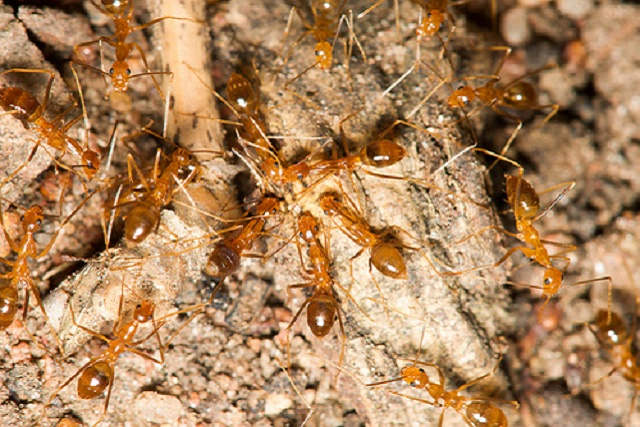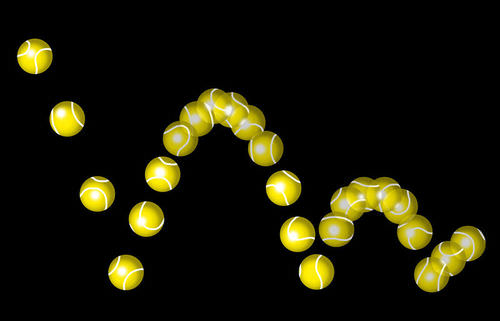生物化学能 - 先进
Section outline
-
What is energy? Where does your energy come from? Can energy be recycled?
::能量是什么 你的能量来自何方?能源可以回收吗?This team of ants is breaking down a dead tree. A classic example of teamwork. And all that work takes energy . In fact, each chemical reaction - the chemical reactions that allow the in those ants to do the work - needs energy to get started. And all that energy comes from the food the ants eat. Whatever eats the ants gets their energy from the ants. Energy passes through an in one direction only.
::这群蚂蚁正在摧毁一棵枯树。一个典型的团队合作范例。所有工作都需要能量。事实上,每一种化学反应 — — 允许蚂蚁做工的化学反应 — — 都需要能量才能启动。所有能量都来自蚂蚁吃的食物。无论蚂蚁吃什么,它们都能从蚂蚁身上得到能量。能源仅向一个方向扩散。Matter and Energy
::物质与能源All living things are made of matter . In fact, matter is the “stuff” of which all organisms are made. Anything that occupies space and has mass is known as matter. Matter, in turn, consists of chemical substances. It is the carbons, hydrogens, oxygens and other elements that combine to form molecules, compounds, , cells and eventually tissues , organs and organisms. In addition to being made of matter, all living organisms also need energy to survive.
::所有生物都是由物质组成的。事实上,物质是所有生物的“物质 ” 。 占据空间和有质量的任何东西都被称为物质。 物质又由化学物质组成。 碳、氢、氧和其他元素是分子、化合物、细胞和最终组织、器官和生物体的结合体。 除了物质外,所有生物体也需要能量才能生存。Energy is a property of matter that is defined as the ability to do work. The concept of energy is useful for explaining and predicting most natural phenomena, and it is the foundation for an understanding of biology . All living organisms need energy to grow and reproduce. However, energy can never be created nor destroyed. Energy can only be transformed. That is, energy is always conserved. This is called the law of of energy . Therefore, organisms cannot create the energy they need. Instead, they must obtain energy from the environment. Organisms also cannot destroy or use up the energy they obtain. They can only change it from one form to another. Organisms will either use their energy (for metabolism) or release it to the environment as heat.
::能源是被定义为工作能力的一种物质属性。 能源的概念对于解释和预测大多数自然现象是有用的, 它是了解生物学的基础。 所有生物都需要能源来生长和繁殖。 但是,能源是永远无法创造或摧毁的。 能源只能被改变。 也就是说, 能源总是被保护的。 这被称为能源法则。 因此, 有机体不能创造它们所需要的能源。 相反, 它们必须从环境中获取能源。 有机体也不能摧毁或使用它们获得的能源。 它们只能将能源从一种形式改变为另一种形式。 有机体要么利用它们的能源( 代谢性) , 要么将其释放到环境中作为热力。In biology, energy is required for ecosystems to survive, as all living organisms need energy. Within an organism, energy is needed for growth and of a biological cell or an organelle within that cell. Energy is also needed for all biochemical reactions within that cell. Therefore, energy is stored within cells in the chemical bonds of substances such as (including sugars), , and . This energy is released during aerobic respiration .
::在生物学中,生态系统需要能源才能生存,因为所有活生物体都需要能源。在生物体中,需要能源来生长和生物细胞或该细胞内的有机体。该细胞内的所有生化反应也需要能源。因此,能量储存在细胞中的化学链条中,如物质(包括糖 ) , 以及。这种能量在有氧呼吸中释放。The energy for most living organisms initially originates from the sun. This energy is absorbed by , usually photosynthetic organisms such as plants. Plants convert this energy into chemical energy, in the form of carbohydrates, such as glucose . Energy can be stored in this state, or converted into a usable form of energy, adenosine triphosphate (ATP) . This occurs in both the plant, as well as the organisms that eat the plant, or eat the organism that ate the plant.
::大部分活生物体的能量最初来自太阳。 这种能量由植物等光合生物吸收,通常是植物等光合生物吸收。 植物将这种能量转换成化学能源, 以碳水化合物的形式, 如葡萄糖。 能量可以储存在这种状态, 或者转换成一种可用的能量形式, 三磷酸乙烷(ATP ) 。 这既发生在植物中,也发生在食用植物或食用植物有机体的有机体中。Forms of Energy
::能源形式Energy can take several different forms. Common forms of energy include light, chemical, and heat energy. Other common forms are kinetic and potential energy.
::能源可以有几种不同的形式,常见的能源形式包括光、化学和热能,其他常见的形式是动能和潜在能源。How Organisms Change Energy
::生物如何改变能源In organisms, energy is always changing from one form to another. For example, plants obtain light energy from sunlight and change it to chemical energy in food molecules, such as glucose. Chemical energy is energy stored in bonds between atoms within food molecules. When other organisms eat and digest the food, they break the chemical bonds and release the chemical energy. Organisms do not use energy very efficiently. About 90 percent of the energy they obtain from food is converted to heat energy that is given off to the environment.
::在生物体中,能源总是从一种形式变化到另一种形式。例如,植物从阳光中获得光能,并将它改变为诸如葡萄糖等食品分子中的化学能源。化学能源是储存在食物分子中的原子之间的能量。当其他生物吃和消化食物时,它们会打破化学链并释放化学能源。生物体没有非常有效地使用能源。它们从食物中获取的能源中,大约90%被转化为热能,而热能则被排放到环境中。Kinetic and Potential Energy
::动力和潜在能源Energy also constantly changes back and forth between kinetic and potential energy. Kinetic energy is the energy of movement . For example, a ball falling through the air has kinetic energy because it is moving ( Figure ). The random motion of molecules is due to kinetic energy, and the driving force behind .
::能量在动能和潜在能量之间也不断变化。动能是运动的能量。例如,一个球在空气中坠落,因为它在移动而具有动能(图 ) 。分子的随机运动是由于动能和动力。Potential energy is the energy stored in an object due to its position. A bouncing ball at the top of a bounce, just before it starts to fall, has potential energy. For that instant, the ball is not moving, but it has the potential to move because gravity is pulling on it. Once the ball starts to fall, the potential energy changes to kinetic energy. When the ball hits the ground, it gains potential energy from the impact. The potential energy changes to kinetic energy when the ball bounces back up into the air. As the ball gains height, it regains potential energy because of gravity.
::潜在能量是根据其位置存储在物体中的能量。 弹跳顶部的弹跳球, 就在它开始坠落之前, 就有潜在的能量。 此时球没有移动, 但是它有移动的潜力, 因为重力正在拉动它。 一旦球开始下降, 潜在的能量会变成动能。 当球撞击到地面时, 它会从撞击中获取潜在的能量。 当球弹回空气时, 潜在的能量会变成动能。 随着球升到高度, 它会因重力而重新获得潜在的能量。Energy in a bouncing ball is transformed from potential energy to kinetic energy and then back to potential energy. This cycle of energy changes keeps repeating as long as the ball continues to bounce. The ball rises less on each successive bounce because some energy is used to resist air molecules.
::弹跳球中的能量从潜在的能量转变为动能,然后又回到潜在的能量。只要球继续弹出,这种能量变化循环就会不断重复。球的连续弹出速度就会减少,因为有些能量被用来抵抗空气分子。Like the ball, every time you move you have kinetic energy — whether you jump or run or just blink your . Can you think of situations in which you have potential energy? Obvious examples might include when you are standing on a diving board or at the top of a ski slope or bungee jump. What gives you potential energy in all of these situations? The answer is gravity.
::就像球一样,每次移动时,你都有动能——无论跳或跑,还是眨眼——你能想到有潜在能量的情况吗?明显的例子可能包括当你站在潜水板上,或站在滑雪斜坡或大腿跳跃的顶部时。在所有这些情况下,什么能给你潜在的能量?答案是引力。Summary
::摘要-
Energy is a property of matter. It cannot be created or destroyed.
::能源是物质财产,不能创造或摧毁能源。 -
Organisms obtain light energy from sunlight or chemical energy from food and change the energy into different forms, including heat energy.
::生物从阳光中获得光能,或从食物中获得化学能源,并将能源改变为不同形式,包括热能。
Review
::回顾-
What is energy?
::什么是能源? -
Describe two ways that energy changes form in the following sequence of events: A plant grows in the sun. → A rabbit eats the plant.
::描述能量变化在以下一系列事件中形成的两种方式: 植物在太阳下生长。 兔子吃植物。 -
Describe a real-life situation in which the energy of an object or person changes back and forth between kinetic energy and potential energy. Identify each time energy changes form.
::描述一个物体或人的能量在动能和潜在能量之间回回变化的实际情况。
-
Energy is a property of matter. It cannot be created or destroyed.

